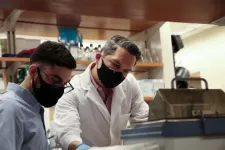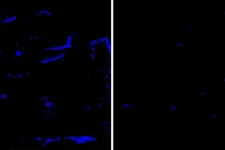(Press-News.org) A considerable portion of the efforts to realize a sustainable world has gone into developing hydrogen fuel cells so that a hydrogen economy can be achieved. Fuel cells have distinctive advantages: high energy-conversion efficiencies (up to 70%) and a clean by-product, water. In the past decade, anion exchange membrane fuel cells (AEMFC), which convert chemical energy to electrical energy via the transport of negatively charged ions (anions) through a membrane, have received attention due to their low-cost and relative environment friendliness compared to other types of fuel cells. But while inexpensive, AEMFCs suffer from several major drawbacks such as low ion conductivity, low chemical stability of the membrane, and an overall lower performance rate than its counterparts. Now, in a study published in the Journal of Materials Chemistry A, scientists from Korea report a novel membrane that is both thin and strong, and takes care of these drawbacks.
To develop their membrane, the scientists used a novel method: they chemically bonded two commercially available polymers, poly(2,6-dimethyl-1,4-phenylene oxide) (PPO) and poly(styrene-b-(ethylene-co-butylene)-b-styrene) (SEBS) without using a crosslinking agent. Professor Tae-Hyun Kim from Incheon National University, who led the study, explains, "A previous study made a similar attempt to fabricate anion exchange membranes (AEMs) by crosslinking PPO and SEBS with diamine as a crosslinking agent. While the AEMs displayed excellent mechanical stability, the use of diamine could have led to different reactions other than those between PPO and SEBS, which made it difficult to control the properties of the resultant membrane. Therefore, in our study, we crosslinked PPO and SEBS without any crosslinking agent to ensure that only PPO and SEBS react with each other." The strategy used by Prof. Kim's team also involved adding a compound called triazole to PPO to increase the membrane's ion conductivity.
Membranes fabricated using this method were up to 10 μm thin and had excellent mechanical strength, chemical stability, and conductivity at even a 95% room humidity. Together, these conferred a high overall performance to the membrane and to the corresponding fuel cell on which the scientists tested their membrane. When operated at 60°C, this fuel cell exhibited stable performance for 300 hours with a maximum power density surpassing those of existing commercial AEMs and matching cutting-edge ones.
Excited about the future prospects of this novel promising AEM, Prof. Kim says, "The polymer electrolyte membranes in our study can be applied not only to fuel cells that generate energy, but also to water electrolysis technology that produces hydrogen. Therefore, I believe this research will play a vital role in revitalizing the domestic hydrogen economy."
Perhaps that clean and green world we envision is not far away!
INFORMATION:
Reference
Authors: Seounghwa Sung (1,2), Ji Eon Chae (3), Kyunghwan Min (1,2), Hyoung-Juhn Kim (3), Sang Yong Nam (4), and Tae-Hyun Kim (1,2)
Title of original paper: Preparation of crosslinker-free anion exchange membranes with excellent physicochemical and electrochemical properties based on crosslinked PPO-SEBS
Journal: Journal of Materials Chemistry A
DOI: 10.1039/d0ta10194j
Affiliations:
(1) Organic Material Synthesis Laboratory, Department of Chemistry, Incheon National University
(2) Research Institute of Basic Sciences, Incheon National University
(3) Centre for Hydrogen and Fuel Cell Research, Korea Institute of Science and Technology
(4) Department of Materials Engineering and Convergence Technology, Engineering Research Institute, Gyeongsang National University
About Incheon National University
Incheon National University (INU) is a comprehensive, student-focused university. It was founded in 1979 and given university status in 1988. One of the largest universities in South Korea, it houses nearly 14,000 students and 500 faculty members. In 2010, INU merged with Incheon City College to expand capacity and open more curricula. With its commitment to academic excellence and an unrelenting devotion to innovative research, INU offers its students real-world internship experiences. INU not only focuses on studying and learning but also strives to provide a supportive environment for students to follow their passion, grow, and, as their slogan says, be INspired.
Website: http://www.inu.ac.kr/mbshome/mbs/inuengl/index.html
About the author
Dr. Tae-Hyun Kim is a Chemistry Professor at Incheon National University (INU), Korea. He is also director of the Research Institute of Basic Sciences at INU. Dr. Kim received a Ph.D. in Chemistry from Cambridge University, UK, and conducted his post-doctoral research at MIT, USA. Before joining INU, he was a senior research associate at Eastman Chemical Co., USA. His research interests lie in the development of organic materials for various applications, including fuel cells, lithium batteries, water electrolysis, and gas separation. He has authored over 120 SCI journal articles and holds more than 50 patents.
CHAMPAIGN, Ill. -- Researchers who focus on fat know that some adipose tissue is more prone to inflammation-related comorbidities than others, but the reasons why are not well understood. Thanks to a new analytical technique, scientists are getting a clearer view of the microenvironments found within adipose tissue associated with obesity. This advance may illuminate why some adipose tissues are more prone to inflammation - leading to diseases like type 2 diabetes, cancer and cardiovascular disorders - and help direct future drug therapies to treat obesity.
In a new study, University of Illinois ...
A short-lived resurgence in the emission of ozone depleting pollutants in eastern China will not significantly delay the recovery of Earth's protective "sunscreen" layer, according to new research published Feb. 10 in Nature.
Stratospheric ozone, also known as Earth's ozone layer, helps shield us from the Sun's harmful Ultraviolet (UV) rays. Compounds like CFC-11 (Trichlorofluoromethane, also known as Freon-11), a chemical once considered safe and widely used as a refrigerant and in the production of insulation for buildings, rise to the stratosphere after emission on Earth's surface. Once in the atmosphere, CFC's are broken down by the UV light and result in the destruction of ozone molecules, both reducing stratospheric ozone concentrations globally ...
A neural network system that analyzes photographs can rank and distinguish suspicious, potentially precancerous skin lesions, which can turn into the deadly skin malignancy melanoma if not caught and removed early. The system accurately scoped out suspicious lesions from 68 patients in a manner that mostly matched tried-and-true evaluations from dermatologists. The results suggest the platform could help clinicians spot suspicious lesions during clinical visits faster and on a larger scale, potentially allowing for earlier diagnosis and treatment. Melanoma is ...
Understanding the molecular biology of brain tumors is key to prognosis and treatment said Le Bonheur Neuroscience Institute Co-Director Frederick Boop, MD, in his presentation "How Molecular Biology Impacts Clinical Practice" at the International Society for Pediatric Neurosurgery (ISPN) 2020 Virtual Meeting.
"Historically we have depended on what we see under a microscope to differentiate tumor types and determine prognosis and therapy," said Boop. "We know now that what we see doesn't necessarily predict how these tumors are going to behave."
Physicians are able to send a piece of a child's tumor to FoundationOne, an FDA-approved tissue-based broad companion diagnostic (CDx) for solid tumors, which provides the genomic alterations of that particular tumor. ...
A new UBC Okanagan study finds children not only reap the benefits of working with therapy dogs-they enjoy it too.
"Dog lovers often have an assumption that canine-assisted interventions are going to be effective because other people are going to love dogs," says Nicole Harris, who conducted this research while a master's student in the School of Education. "While we do frequently see children improve in therapy dog programs, we didn't have data to support that they enjoyed the time as well."
Harris was the lead researcher in the study that explored how children reacted while participating in a social skill-training program with therapy dogs.
The research saw 22 children from the Okanagan Boys and Girls ...
Resistance to tangle formation may help preserve memory
SuperAgers have fewer tangles than normally aging individuals
Future research to see how SuperAgers are protected
CHICAGO - A new Northwestern Medicine study showed cognitive SuperAgers have resistance to the development of fibrous tangles in a brain region related to memory and which are known to be markers of Alzheimer's disease.
The tangles are made of the tau protein which forms structures that transport nutrients within the nerve cell. These tangles disrupt the cell's transport system, ...
Nearly a half-million people a year die from sudden cardiac death (SCD) in the U.S. -- the result of malfunctions in the heart's electrical system.
A leading cause of SCD in young athletes is arrhythmogenic cardiomyopathy (ACM), a genetic disease in which healthy heart muscle is replaced over time by scar tissue (fibrosis) and fat.
Stephen Chelko, an assistant professor of biomedical sciences at the Florida State University College of Medicine, has developed a better understanding of the pathological characteristics behind the disease, as well as promising avenues for ...
The trial found that using sensor-based asthma inhalers may improve control of the condition and improve the quality of life for caregivers.
Greatest gains were among non-Hispanic Black participants, who experience more frequent and severe asthma than other groups.
Based on the study results, this asthma intervention should be considered for use by primary care, allergy and pulmonary care providers, to help engage diverse populations of pediatric asthma patients and their caregivers.
CHICAGO (February 17, 2021) -- Sensor-based inhalers integrated into health care providers' clinical workflows may help improve medication adherence and support children with asthma - and their families - to more effectively manage this condition, according ...
Numerous studies have shown that trained dogs can detect many kinds of disease -- including lung, breast, ovarian, bladder, and prostate cancers, and possibly Covid-19 -- simply through smell. In some cases, involving prostate cancer for example, the dogs had a 99 percent success rate in detecting the disease by sniffing patients' urine samples.
But it takes time to train such dogs, and their availability and time is limited. Scientists have been hunting for ways of automating the amazing olfactory capabilities of the canine nose and brain, in a compact device. Now, a team of researchers at MIT and other institutions has come up with a system that can detect the chemical and microbial content of an air sample with ...
As people age, a normal brain protein known as amyloid beta often starts to collect into harmful amyloid plaques in the brain. Such plaques can be the first step on the path to Alzheimer's dementia. When they form around blood vessels in the brain, a condition known as cerebral amyloid angiopathy, the plaques also raise the risk of strokes.
Several antibodies that target amyloid plaques have been studied as experimental treatments for Alzheimer's disease. Such antibodies also may have the potential to treat cerebral amyloid angiopathy, although they haven't yet been evaluated in clinical trials. ...





